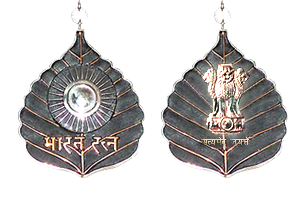
The Bharat Ratna is the highest civilian award of the Republic of India. Instituted on 2 January 1954, the award is conferred in recognition of "exceptional service/performance of the highest order", without distinction of race, occupation, position or gender. The award was originally limited to achievements in the arts, literature, science, and public services, but the Government of India expanded the criteria to include "any field of human endeavor" in December 2011. The recommendations for the award are made by the Prime Minister to the President. The recipients receive a Sanad (certificate) signed by the President and a peepal leaf-shaped medallion with no monetary grant associated with the award. Bharat Ratna recipients rank seventh in the Indian order of precedence.
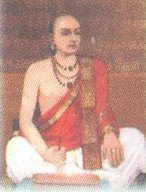
Nannayya Bhattaraka or Nannayya Bhattopadhyaya was a Telugu poet and the author of Andhra Mahabharatam, a Telugu retelling of the Sanskrit-language Mahabharata. Nannaya is generally considered the first poet of Telugu language. He was patronized by Rajaraja Narendra of Rajamahendravaram. Rajaraja Narendra was an admirer of Mahabharata and wanted the message of the Sanskrit epic to reach the Telugu masses in their own language and idiom. He commissioned Nannaya, a scholar well versed in Vedas, Puranas, and Itihasas for the task. Nannaya began his work in c. 1025 CE and wrote Adi Parvam, Sabaparvam, and a part of Aranyaparvam.
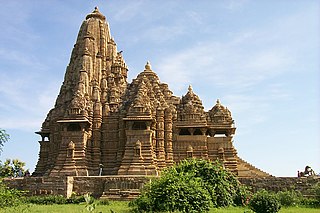
Hindu temple architecture as the main form of Hindu architecture has many varieties of style, though the basic nature of the Hindu temple remains the same, with the essential feature an inner sanctum, the garbha griha or womb-chamber, where the primary Murti or the image of a deity is housed in a simple bare cell. For rituals and prayers, this chamber frequently has an open space that can be moved in a clockwise direction. There are frequently additional buildings and structures in the vicinity of this chamber, with the largest ones covering several acres. On the exterior, the garbhagriha is crowned by a tower-like shikhara, also called the vimana in the south. The shrine building often includes an circumambulatory passage for parikrama, a mandapa congregation hall, and sometimes an antarala antechamber and porch between garbhagriha and mandapa. In addition to other small temples in the compound, there may be additional mandapas or buildings that are either connected or separate from the larger temples.
Śrīpati, also transliterated as Shri-pati, was an Indian astronomer, astrologer and mathematician. His major works include Dhīkotida-karana (1039), a work of twenty verses on solar and lunar eclipses; Dhruva-mānasa, a work of 105 verses on calculating planetary longitudes, eclipses and planetary transits; Siddhānta-śekhara a major work on astronomy in 19 chapters; and Gaṇita-tilaka, an incomplete arithmetical treatise in 125 verses based on a work by Shridhara.

The unification of Nepal was the process of building the modern Nepalese state, from fractured petty kingdoms including the Baise Rajya and the Chaubisi Rajya, which began in 1743 AD. The prominent figure in the unification campaign was Prithvi Narayan Shah, King of Gorkha. On 25 September 1768, he officially announced the creation of the Kingdom of Nepal and moved his capital from Gorkha to the city of Kathmandu.
Gargi Vachaknavi, was an ancient Indian sage and philosopher. In Vedic literature, she is honoured as a great natural philosopher, renowned expounder of the Vedas, and known as Brahmavadini, a person with knowledge of Brahma Vidya. In the Sixth and the eighth Brahmana of Brihadaranyaka Upanishad, her name is prominent as she participates in the brahmayajna, a philosophic debate organized by King Janaka of Videha and she challenges the sage Yajnavalkya with perplexing questions on the issue of atman (soul). She is also said to have written many hymns in the Rigveda. She remained a celibate all her life and was held in veneration by the conventional Hindus.

Drohkaal is a 1994 Indian Hindi-language action drama film directed and produced by Govind Nihalani, which deals with India's fight against terrorism. The film examines the mental and psychological trauma that honest police officers go through in their fight against a group of ruthless terrorists. It was remade simultaneously in 1995 in Tamil and Telugu as Kuruthipunal and Drohi.
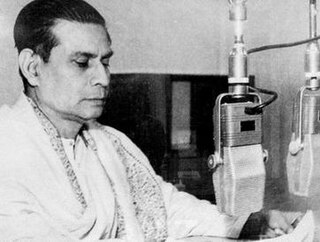
Birendra Krishna Bhadra (1905–1991) was a radio broadcaster, playwright, actor, narrator and theatre director from Kolkata, India and a contemporary of Pankaj Mallick and Kazi Nazrul Islam. He worked for the All India Radio, India's National Radio broadcaster for several years during its early, starting 1930s, and during this period he produced and adapted several plays.
A jyotiḥśāstra is a text from a classical body of literature on the topic of Hindu astrology, known as Jyotiṣa, dating to the medieval period of Classical Sanskrit literature. Only the most important ones exist in scholarly editions or translations, while many remain unedited in Sanskrit or vernacular manuscripts.
Vaitheeswaran is a 2008 Tamil language fantasy action film written and directed by R. K. Vidyadharan. It starred Sarath Kumar, Meghna Naidu and Pooja Gandhi, while Sayaji Shinde, Riyaz Khan, Vijayakumar, Santhanam, and Vinaya Prasad play supporting roles. The music was composed by Srikanth Deva, and the film was released on 14 March 2008.

Ravindra Kumar is a Political Scientist, Peace Educator, an Indologist, a Humanist, Cultural Anthropologist and a former Vice-Chancellor of CCS University, Meerut (India).

Rukmini Vijayakumar is an Indian choreographer, Bharatanatyam dancer, and actress. Along with her performances on stage, she has appeared in films such as Ananda Thandavam (2009), Bhajarangi (2013), Kochadaiyaan (2014), Final Cut of Director (2016), Kaatru Veliyidai (2017), and Sita Ramam (2022)

The Bhadra Dam or Lakkavalli Dam, which has created the Bhadra Reservoir, is located on the Bhadra River a tributary of Tungabhadra River. Bhadra Dam is located in the border of Bhadravathi and Tarikere, in the western part of Karnataka in India. The benefits derived from the reservoir storage are irrigation with gross irrigation potential of 162,818 hectares, hydro power generation of 39.2 MW, drinking water supply and industrial use. The dam commissioned in 1965 is a composite earth cum masonry structure of 59.13 metres (194.0 ft) height with length of 1,708 metres (5,604 ft) at the crest level, which submerges a land area of 11,250.88 hectares.
Jataka Parijata is an Indian astrological text that is ranked alongside Bṛhat Parāśara Horāśāstra of Parāśara Muni, Bṛhat Jātaka of Varāhamihira and Phaladīpikāḥ of Mantreśvara. It is regularly studied as a textbook and a reliable reference-book, and is one of the few books that gives time on the nativity, the other two being Horā Ratnaṃ and Jātaka Bharaṇaṃ.
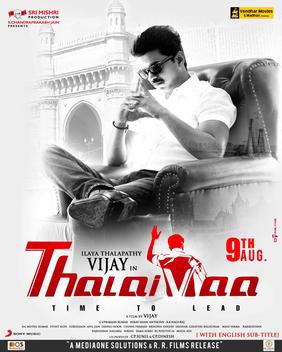
Thalaivaa is a 2013 Indian Tamil-language action thriller film written and directed by A. L. Vijay. It stars Vijay in the title role. The film, produced by Chandraprakash Jain, features background score and soundtrack composed by G. V. Prakash Kumar with cinematography and editing handled by Nirav Shah and Anthony respectively. The story revolves around a dancer who takes over his father's duty as a crime boss after his death. The film also stars with an ensemble supporting cast includes Amala Paul, Ragini Nandwani, Sathyaraj, Santhanam, Abhimanyu Singh and others.
Hora Sara is an ancient treatise on Hindu astrology, in relation to divination, written in the Sanskrit Sloka format. Its author, Prithuyasas, was the son of Varahamihira.
Garga Horā is a very ancient treatise on the predictive part of Hindu astrology. Its author, Ṛṣi Garga, is one of the sages of the Purāṇika times. He was the son of Ṛṣi Bharadvāja. There are 8 Siddhāntas of Hindu astrology, they are – Brahmā, Sūrya, Soma, Vasiṣṭhta, Pulastya, Romaka, Arya, and Garga Siddhāntas – the last named is named after the author of Garga Horā, and Garga Saṁhitā, and with whom Jyotiṣa is associated. Garga Horā is written in the Sanskrit Sutra – format and from this work Varāhamihira has drawn profusely. Incidentally, both, Garga and Varāhamihira, have in their respective works referred to the proficiencies of the Greeks in the field of Astronomy.

Bala Murugan, better known by his stage name Gana Bala is an Indian playback singer in Tamil cinema. He rose to prominence after rendering the songs 'Aadi Pona Aavani' and 'Nadukadalula Kappala' from the soundtrack of Attakathi. He has predominantly sung songs belonging to the gaana genre of Tamil Nadu. He has been credited for reviving the gaana genre in Tamil Cinema after 'Thenisai Thendral' Deva. He has also penned lyrics for some of his songs.

The term Upachayasthana is derived from the Sanskrit word उपचय which means increase, it also means the entire process of acquisition, assimilation and augmentation or proximate aggregation or increase or gain of nourishment or in growth or in body weight.

Bahut Din Huwe is a 1954 Indian Hindi-language film directed by S. S. Vasan, produced by Gemini Studios and starring Madhubala. It is a remake of the Telugu film Bala Nagamma (1942).













